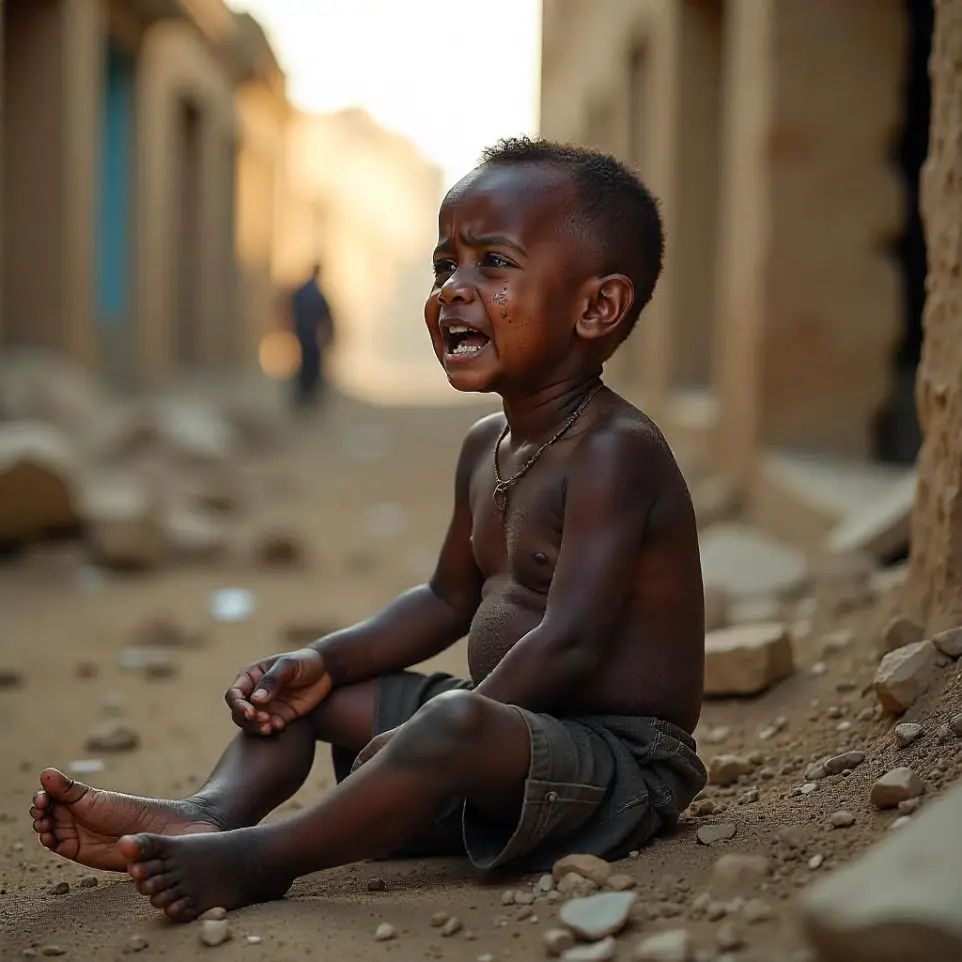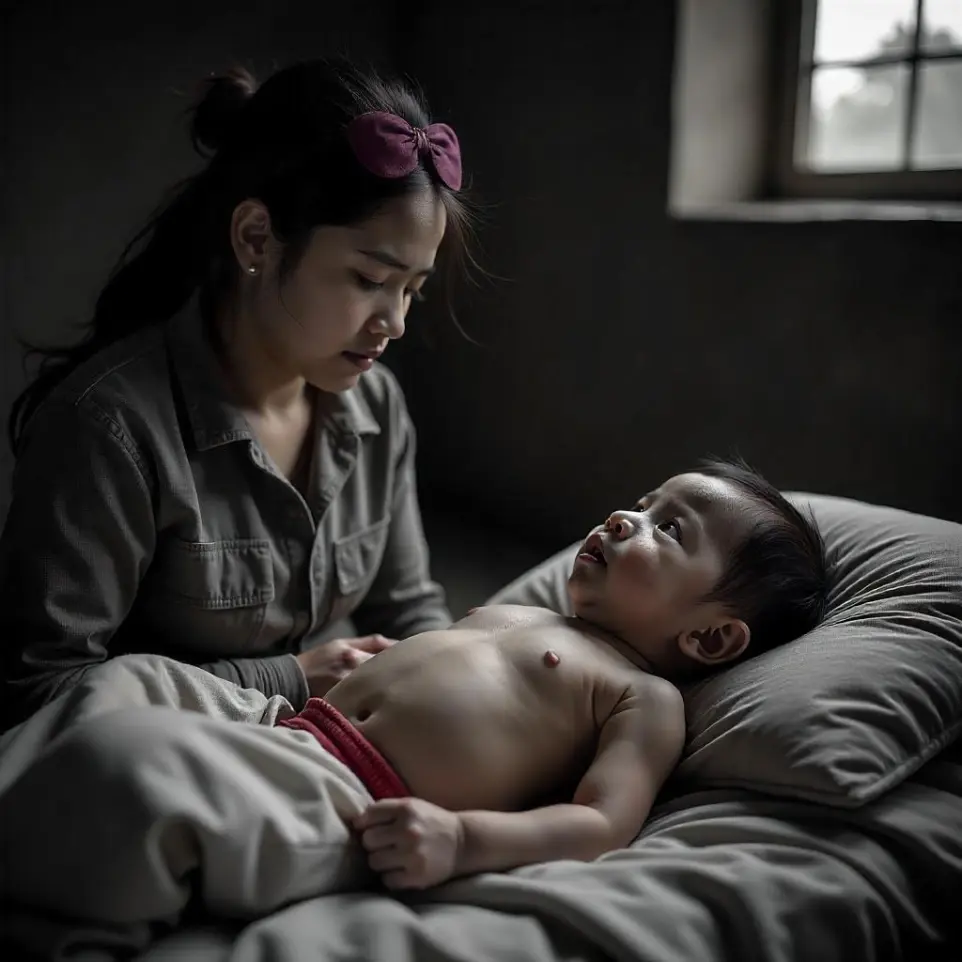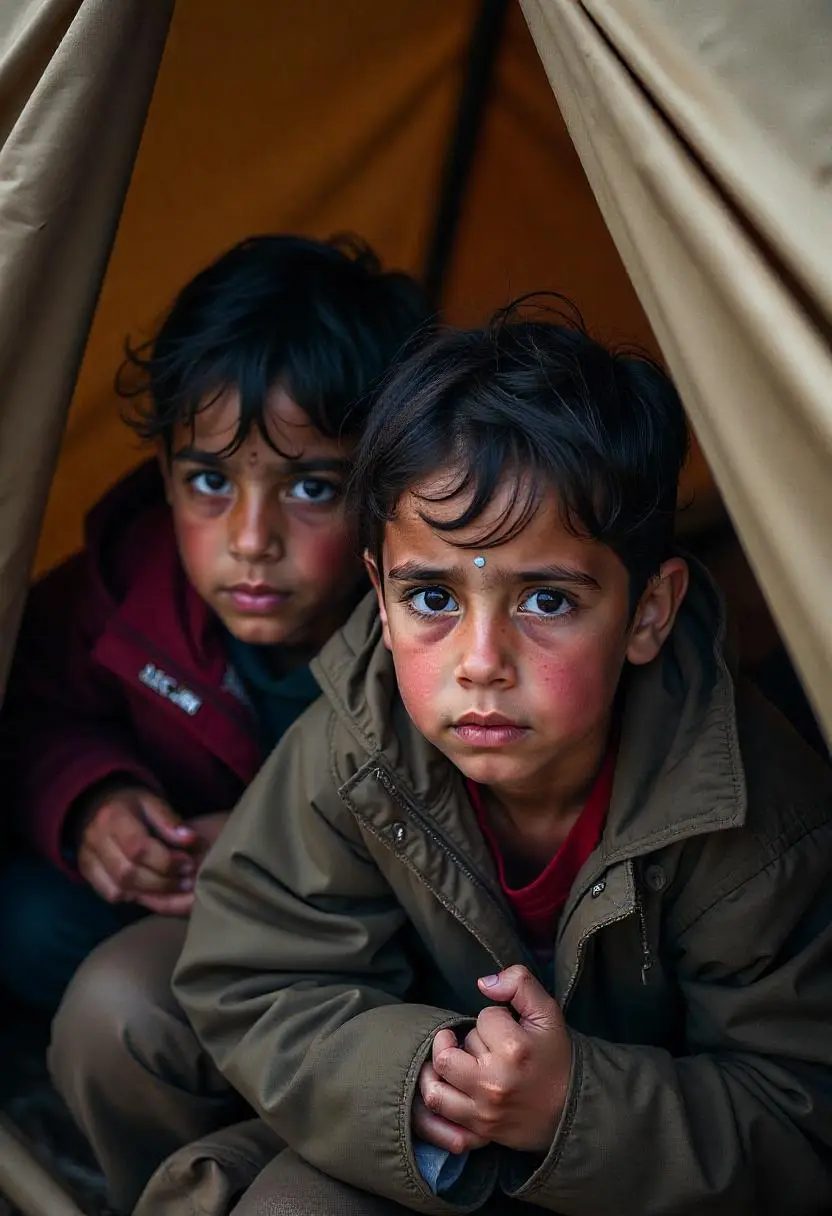





Children at Risk: Malnutrition and Childhood Diseases in Conflict Zones
Here you will find a space dedicated to the in-depth exploration and analysis of human rights at the global level. In our main article, "Children at Risk: Malnutrition and Childhood Diseases in Conflict Zones," we address the shocking problem of childhood malnutrition in conflict zones. We invite you to learn more about this crucial issue and join the fight for the rights of the most vulnerable.
Introduction
Armed conflict has a devastating impact on children, leaving them vulnerable to a range of challenges that threaten their well-being and development. Exposure to violence, lack of access to education, and inadequate healthcare are just some of the consequences children face in these circumstances.
Furthermore, childhood malnutrition, preventable diseases, and lack of adequate healthcare are widespread problems in conflict zones, further exacerbating the plight of children.
Childhood is a crucial stage in human development, and the impact of armed conflict on children can have long-term consequences on their physical, mental, and emotional health, as well as their ability to reach their full potential.
Access to health care is critical to ensuring the well-being of children living in conflict zones. The lack of adequate health services and scarcity of medical resources can significantly exacerbate children's health risks, particularly in terms of malnutrition and preventable diseases.
Access to quality health care, the availability of vaccines, and nutritional care are crucial to addressing children's health needs in these areas. However, logistical and security challenges can hinder the effective provision of health services in settings affected by armed conflict.
Ensuring access to health care in conflict zones is not only a humanitarian issue, but also essential to protecting children's fundamental rights and preserving their dignity in extremely difficult situations.
Childhood malnutrition is one of the most serious and urgent consequences of armed conflicts worldwide. Lack of access to nutritious food, disruption of nutrition programs, and economic instability contribute significantly to the prevalence of malnutrition among children in conflict zones.
Childhood malnutrition not only has an immediate impact on children's health but can also have long-term effects on their physical and cognitive development. Malnourished children are at greater risk of disease, have lower academic performance, and face significant obstacles to breaking the cycle of poverty and vulnerability.
Addressing child malnutrition in conflict zones requires a comprehensive approach that includes the provision of nutritious food, specialized medical care, and psychosocial support for children and their families. It is critical that the international community and humanitarian organizations work together to address this crisis effectively and urgently.
Causes of Childhood Malnutrition in Conflict Zones
Childhood malnutrition in conflict zones is a serious problem affecting millions of children worldwide. Scarcity of food and resources is one of the main causes of this problem. In the midst of armed conflict, access to nutritious food is limited, resulting in poor diets for children and their families.
Furthermore, child malnutrition in conflict zones is exacerbated by a lack of access to adequate health services. Communities affected by conflict often lack medical facilities, trained personnel, and basic medical supplies. This makes timely treatment of diseases and conditions related to malnutrition difficult, contributing to further deterioration of children's health.
The situation is worsened by the psychological and emotional impact of conflict on children's nutrition. Stress, fear, and emotional instability can affect children's nutrition, decreasing their intake of essential foods and nutrients. This underestimated factor can have serious consequences for the physical and mental development of children in conflict zones.
Childhood malnutrition in conflict zones can have devastating long-term consequences on children's physical, cognitive, and emotional development. A lack of essential nutrients during the first years of life can result in poor growth, a weakened immune system, and increased susceptibility to infectious diseases. These conditions can lead to delays in cognitive development, learning difficulties, and chronic health problems that last into adulthood.
Furthermore, childhood malnutrition can affect children's emotional development, leading to chronic stress, anxiety, and depression. Lack of access to adequate nutrition in the early years of life can negatively impact children's mental and emotional health, which in turn can affect their ability to develop healthy relationships and lead fulfilling lives in adulthood.
It is critical to understand that the consequences of childhood malnutrition in conflict zones are not limited to the present, but persist throughout the lives of affected children. Therefore, it is crucial to implement effective strategies to address this problem and mitigate its long-term impact on child development.
Challenges in the Prevention and Treatment of Childhood Malnutrition
Childhood malnutrition in conflict zones represents one of the greatest challenges to the protection of human rights today. The distribution of humanitarian aid is severely limited in these contexts, hindering access to adequate food and medical treatment for children at risk. This situation has a significant impact on the health and well-being of children, contributing to high rates of malnutrition and serious illness.
The restrictions imposed by armed conflicts hamper the work of humanitarian organizations, limiting their ability to reach the most vulnerable communities. The lack of safe and sustained access to these areas, coupled with scarce resources, represents a key obstacle in the fight against child malnutrition. This issue requires innovative strategies and a firm commitment from the international community to overcome these limitations and guarantee the protection of children's fundamental rights.
It is essential to reflect on the importance of overcoming these limitations in the distribution of humanitarian aid in order to provide comprehensive care to children affected by malnutrition in conflict zones. This implies the need to develop collaborative approaches that overcome the logistical and political obstacles that hinder the delivery of assistance to those most in need.
The crisis in conflict zones has a devastating impact on health infrastructure, further exacerbating the situation of child malnutrition. Hospitals and healthcare centers are affected by a lack of supplies, trained personnel, and safe conditions to operate effectively. The disruption of basic health services makes it difficult for children to access timely diagnoses and adequate treatment to combat malnutrition and prevent associated diseases.
Furthermore, insecurity in these areas limits the mobility of health professionals and the transportation of essential medicines and supplies. This situation creates a vicious cycle in which the lack of adequate medical care contributes to worsening malnutrition and increasing children's vulnerability to life-threatening diseases.
The crisis in health infrastructure in conflict zones demands an urgent and coordinated international response. Rebuilding and strengthening health systems, along with supporting local health workers, are critical elements in mitigating the impact of child malnutrition and ensuring equitable access to health care for all children, regardless of their location.
Mitigating child malnutrition in conflict zones requires a strong commitment from the international community. Cooperation between governments, non-governmental organizations, and humanitarian agencies is essential to effectively address this humanitarian crisis. Financial and logistical support, as well as the exchange of knowledge and best practices, are key to ensuring that children in these areas receive the necessary care and treatment.
Furthermore, international collaboration is essential to pressure conflict actors to respect humanitarian law and facilitate safe and unhindered access to affected populations. Raising awareness and mobilizing resources at the global level are critical steps to comprehensively address child malnutrition in conflict zones and protect the fundamental rights of children worldwide.
International cooperation plays a crucial role in mitigating child malnutrition in conflict zones, and strengthening it is essential to ensure a safer and healthier future for children facing this serious humanitarian crisis.
Childhood malnutrition in conflict zones is a complex challenge that requires innovative approaches to address its causes and consequences. One key strategy is the implementation of specialized feeding programs, which provide children with access to food enriched with the essential nutrients they need for healthy development.
Another innovative strategy is the use of technology to monitor and assess child malnutrition in real time. Through mobile applications and tracking devices, health workers can quickly identify and treat children at risk, as well as collect data that enables more precise and timely interventions. This combination of technology and medical care is critical for reaching remote and conflict-affected communities where child malnutrition is prevalent.
Furthermore, nutrition education and the empowerment of local communities are essential elements in the fight against child malnutrition in conflict zones. By providing mothers and caregivers with the knowledge and tools necessary to provide adequate nutrition for their children, a sustainable approach is fostered that transcends immediate crises. Strategies that promote community self-sufficiency and resilience are critical to addressing the underlying causes of child malnutrition in conflict-affected settings.
Childhood illnesses in conflict zones
Childhood malnutrition in conflict zones has a significant impact on the prevalence of infectious diseases. When children do not receive the nutrients necessary for proper growth and development, their immune systems weaken, making them more susceptible to diseases such as malaria, cholera, and pneumonia. Malnutrition impairs the body's ability to fight infections, further worsening the health situation of children in these areas.
Malnutrition can also impair the body's ability to respond to vaccines, increasing the risk of contracting preventable diseases. This relationship between malnutrition and infectious diseases creates a devastating cycle that can be difficult to break in conflict settings.
Lack of access to nutritious food, combined with the disruption of health services, contributes to a significant increase in childhood morbidity and mortality in these conflict-affected areas.
In conflict zones, access to vaccines and medical treatment is severely limited, exacerbating malnutrition and childhood illnesses. Disruption of health services and the destruction of medical infrastructure hamper the distribution of essential vaccines and medicines to treat and prevent diseases.
Furthermore, unsafe conditions and a lack of resources make it difficult for medical personnel to provide adequate care to affected children. This combination of factors creates significant barriers to the provision of preventive and curative health services, increasing the risk of illness and complications for children in these areas.
Limited access to vaccines and medical treatment contributes to children's increased vulnerability to infectious diseases, exacerbating the health crisis in conflict zones and increasing the burden on affected communities.
Poor sanitary conditions in conflict zones have a significant impact on children's health, exacerbating malnutrition and increasing the prevalence of childhood illnesses. Lack of access to safe drinking water, adequate sanitation, and hygiene services creates an environment conducive to the spread of infectious diseases.
Malnourished children are even more vulnerable to waterborne and contact-borne diseases, which worsens their health status. The combination of malnutrition, limited access to health services, and poor sanitary conditions creates an alarming context for child health in conflict zones.
Addressing poor sanitary conditions is critical to mitigating the impact of malnutrition and reducing the prevalence of childhood diseases in these conflict-affected areas, thereby protecting children's fundamental right to health.
Exposure to armed conflict situations can have a devastating impact on children's mental health. The trauma caused by war can lead to a range of psychosocial illnesses, such as post-traumatic stress disorder, anxiety, depression, and other stress-related disorders. These effects can last for years or even a lifetime, affecting children's emotional, cognitive, and social development.
The conflict environment can also exacerbate pre-existing problems, such as domestic violence and child abuse. Lack of access to mental health services and adequate psychosocial support further exacerbates the situation. Children living in conflict zones face a heightened risk of mental health problems, which poses a serious threat to their long-term well-being.
To address these psychosocial illnesses, it is crucial to implement psychological and social support programs that provide comprehensive care to children affected by conflict. These programs must be sensitive to local culture and tailored to the specific needs of each community. Furthermore, it is essential to promote education and awareness about the importance of mental health in conflict zones to reduce the stigma associated with psychosocial illnesses and foster a supportive environment for affected children.
Actions and programs to improve access to health care in conflict zones
In conflict zones, child malnutrition is a major health concern. To address this problem, it is crucial to implement specific nutritional and health interventions for children at risk. These interventions may include the distribution of ready-to-use therapeutic foods, vitamin and mineral supplements, and the provision of preventive and curative healthcare services.
Furthermore, it is essential to establish monitoring and evaluation programs to ensure that these interventions are effectively reaching the children who need them. Collaboration with local organizations and training health personnel in affected communities are key elements for the success of these initiatives.
Ultimately, these interventions not only save lives but also lay the foundation for children's healthy development amid adverse environments.
In addition to physical needs, children in conflict zones also face significant emotional and psychological challenges. The traumatic impact of witnessing or being a victim of violence can have lasting effects on children's mental health. Therefore, it is essential to provide specialized psychological and emotional support to help these children cope with the stress, fear, and trauma they have experienced.
Psychosocial support programs can include recreational activities, individual and group therapy, as well as community involvement in creating safe and supportive environments for children. Integrating these services into broader health interventions is critical to comprehensively addressing the needs of children affected by armed conflict.
Access to adequate emotional support not only improves children's mental well-being but also contributes to their ability to recover and develop healthily amid challenging circumstances.
Implementing child health programs in conflict zones presents a number of unique challenges, ranging from insecurity and limited access to a lack of infrastructure and resources. Despite these challenges, there has been significant progress in expanding access to healthcare for children in conflict settings.
Collaboration between governmental, non-governmental, and international organizations has enabled the provision of healthcare services in previously inaccessible areas. Innovations in healthcare delivery, such as the use of mobile clinics and telemedicine, have expanded the reach of child health programs.
However, challenges remain in terms of sustainable financing, coordination of efforts, and effective monitoring of results. Overcoming these challenges requires continued commitment to improving the health of children in conflict zones, as well as constant adaptation to changing conditions on the ground.
Conclusions
Childhood malnutrition in conflict zones is a problem that requires coordinated global action to effectively address it. Lack of access to food, forced displacement, and political and social instability put thousands of children in these areas at risk of malnutrition and related diseases.
Governments, humanitarian organizations, international agencies, and society at large need to work together to provide food assistance, access to health services, and nutrition programs that help prevent and treat child malnutrition in these areas. This coordinated action is essential to protect children's fundamental rights and guarantee them a healthier and more promising future.
The positive impact of access to health care on the protection of children's human rights is undeniable. When children have access to quality health services, including medical care, vaccinations, treatment for common illnesses, and nutrition programs, their ability to grow healthily and develop fully is strengthened. This not only benefits children individually, but also contributes to building stronger and more resilient societies in the long term.

 IHRO NEWS
IHRO NEWS